Day 8. 19/06
Because the weather forecast does not look promising, we decide to spend two nights at the same campsite, and today go through the “golden circle” that we planned to visit anyway. Thanks to that, we will save time to pack the whole equipment, and we are also lighter and drier. At least for one day! 😉 The “Golden Circle” is a route connecting several of the most beautiful, the most spectacular, but also the most commercial points, which are to “tick off” in one day. Ideal for tourists who stay in the capital and going on one-day bus trips.
In the beginning, we want to see the lake in the crater of the Kerið volcano, which was formed about 3000 years ago and is 55 metres in depth. This is the only tourist attraction which you have to pay for in Iceland. By the way, soon there will be more and more of them, because the government wants to limit the influx of tourists, and thus the destruction of nature. The visitors rather will not be discouraged, as they already have to spend a lot on arrival. But there will be funds for the protection and renovation of monuments. We expect intense colours promised by guidebooks and… we find that the place is slightly overrated. The lake is not so turquoise, and the surrounding rocks are not that scarlet. Perhaps the cloudy sky reflecting in the surface of the water turns down the colour saturation.
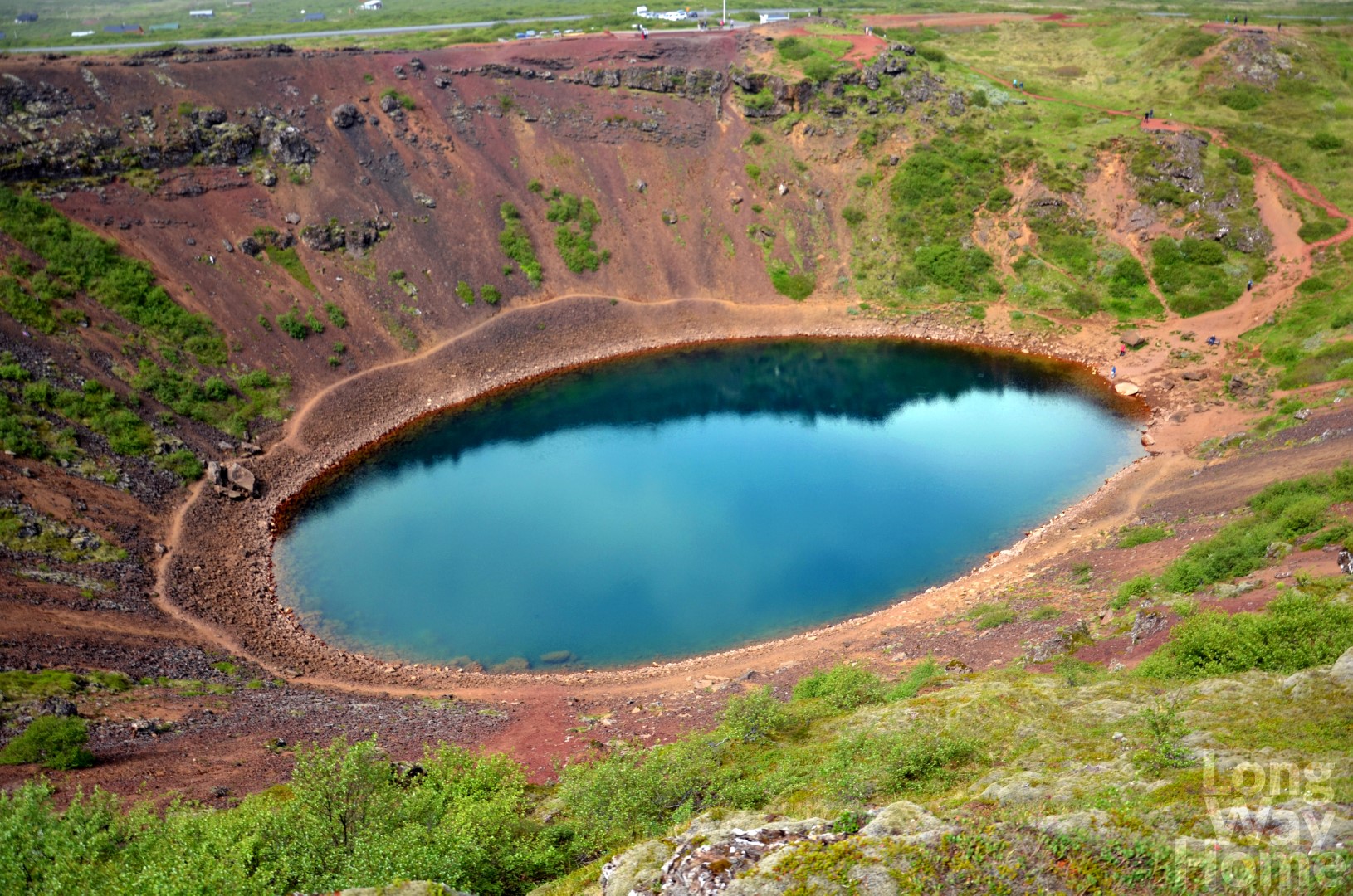
The volcano crater Kerið
Then it comes down to the two-lane Gullfoss waterfall (Golden waterfall), what very impress us. In 1920, the government wanted to lease the place to a foreign investor to build a dam and a hydro-electric power station against the opposition of the landowner. The daughter of the owner, Sigriður, threatened that if the agreement was not broken, she would throw herself into the waterfall. In addition, she walked on foot to Reykjavik gathering her followers along the way. Eventually, the idea failed because of insufficient investors’ funds and the contract expired. Thanks to the girl, we can still admire this amazing place to the accompaniment of the rainbow!
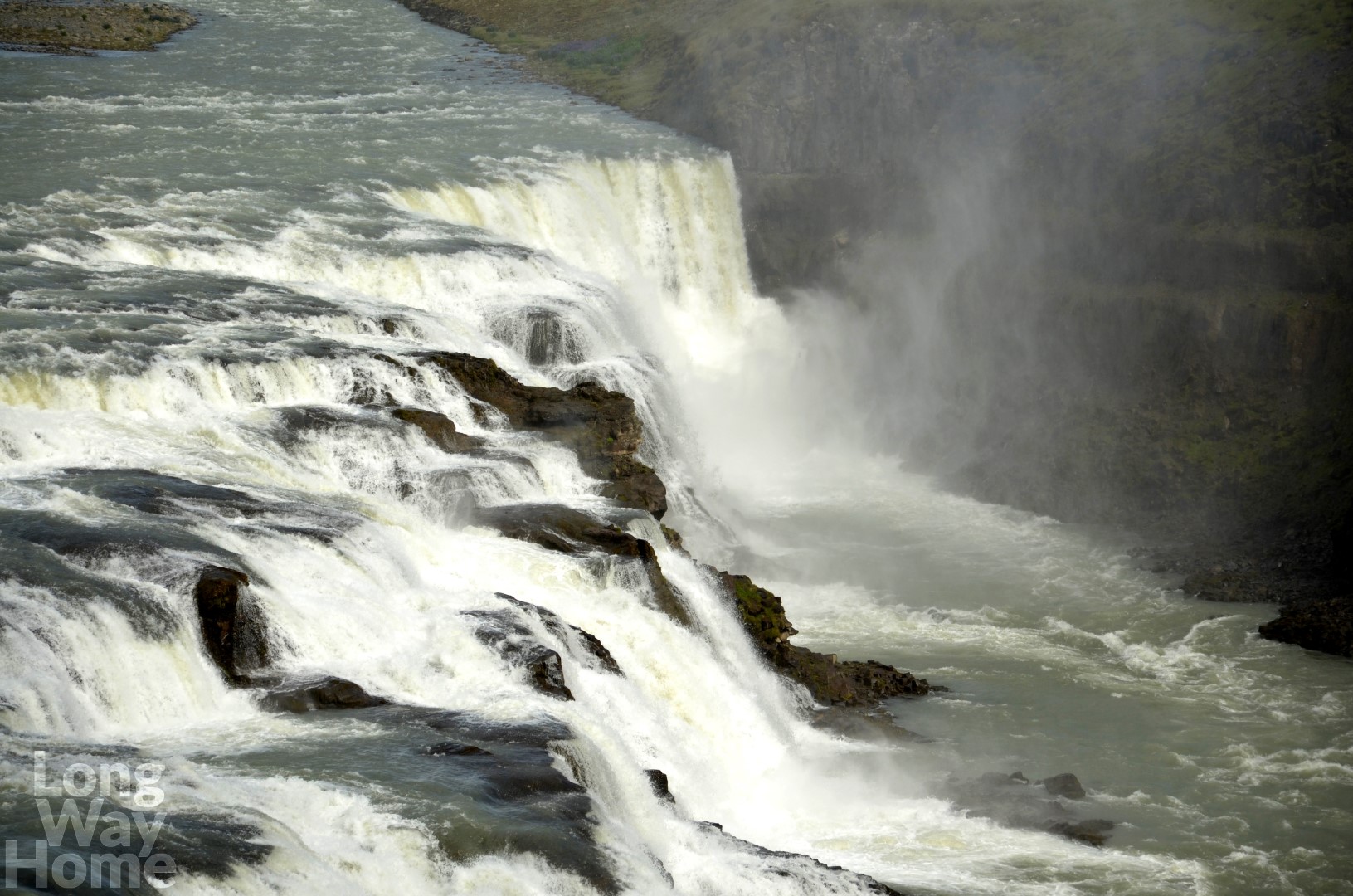
The Gold waterfall
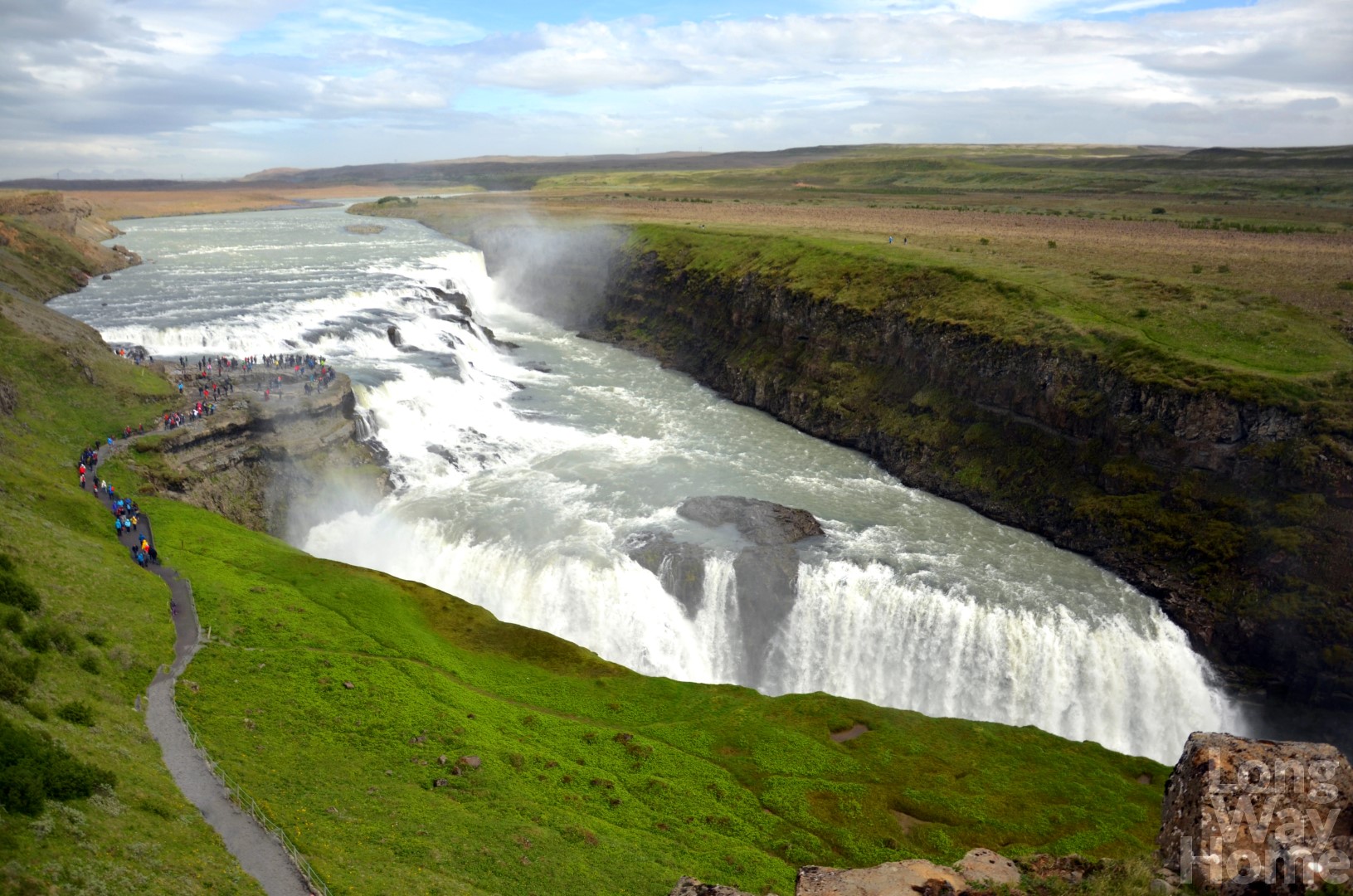
The Gold waterfall
When the pace of our heartbeats drops to the standard frequency, we ride back along the same route to stop at the geysers (explode, squirt) – the most recognisable landmark of Iceland. These are hot springs throwing out a column of boiling water. Magma that flows below, heats up water in a long channel. When it reaches the boiling point, water vapour develops increasing the pressure, which immediately pushes the rest of the water up. The ejected water cools down, returns to the channel, and is heated again by the magma. The cycle closes. The oldest geyser, from which all the geysers in the world took its name (Geysir) was discovered in 1294 and ejected water at 80 metres, but it is inactive anymore.
However, neighbouring Strokkur explodes every 5-10 minutes to a height of about 35 metres. Every time, its eruption is so sudden and unexpected that everyone in tension, with ready cameras, waits for the most interesting. Meanwhile, the geyser seems to laugh in our faces. The water is swaying restlessly, sometimes it bubbles to deceive us and it calms down again… Finally, Strokkur shows us its strength! In the blink of an eye, a huge bubble forms in the channel, which a fraction of a second later is ripped through a water column that shoots up under great pressure. It lasts only a few seconds, causes excitement among visitors… And again we have to wait for the next spectacle. The intensity of the explosion is unpredictable. Sometimes the geyser barely “burps”. Another time, the enormous strength of the ejection surprises our friends by showering them despite the long distance. Fortunately, the water cooled down during the flight and did not burn them.
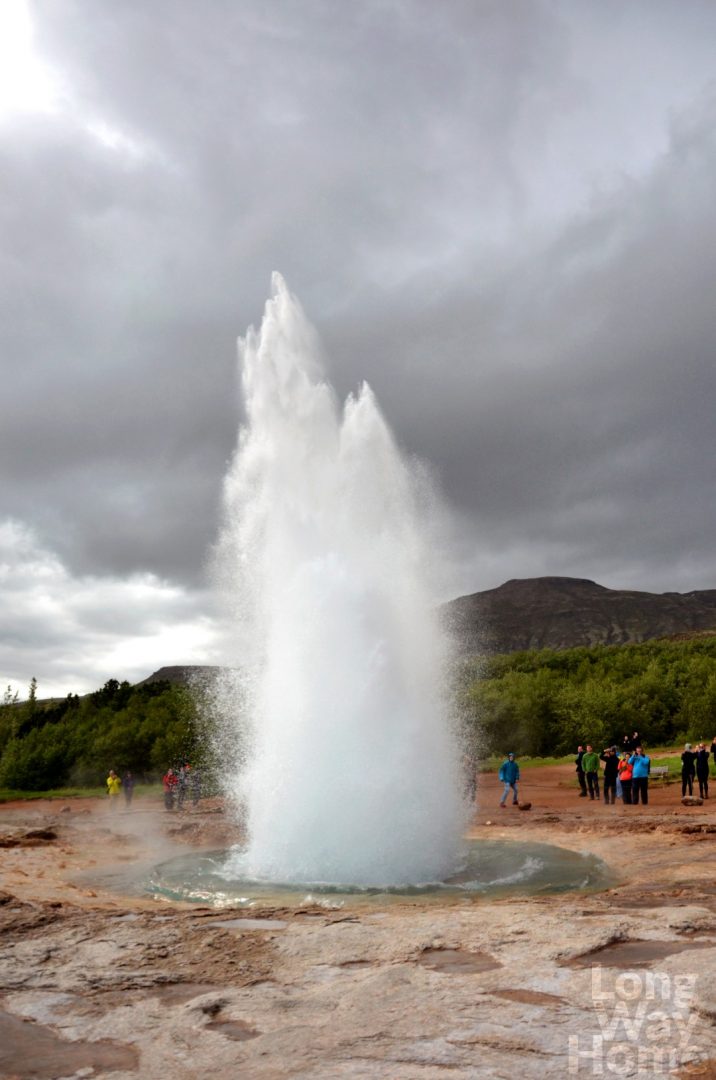
Exploding Strokkur
We also head to the Þingvellir National Park, which was entered on the UNESCO list in 2004. There we find a gap between the Eurasian and North American tectonic plates. There is also a lake where the clarity of water reaches 100 meters. We do not undertake diving, although a license is not required. However, the colour of the water is astonishing. From our point of view, it is hard to determine whether it really is so transparent. Certainly, we can see a deep navy blue colour, and below the small stones sparkling due to sunrays reflecting from the bottom.
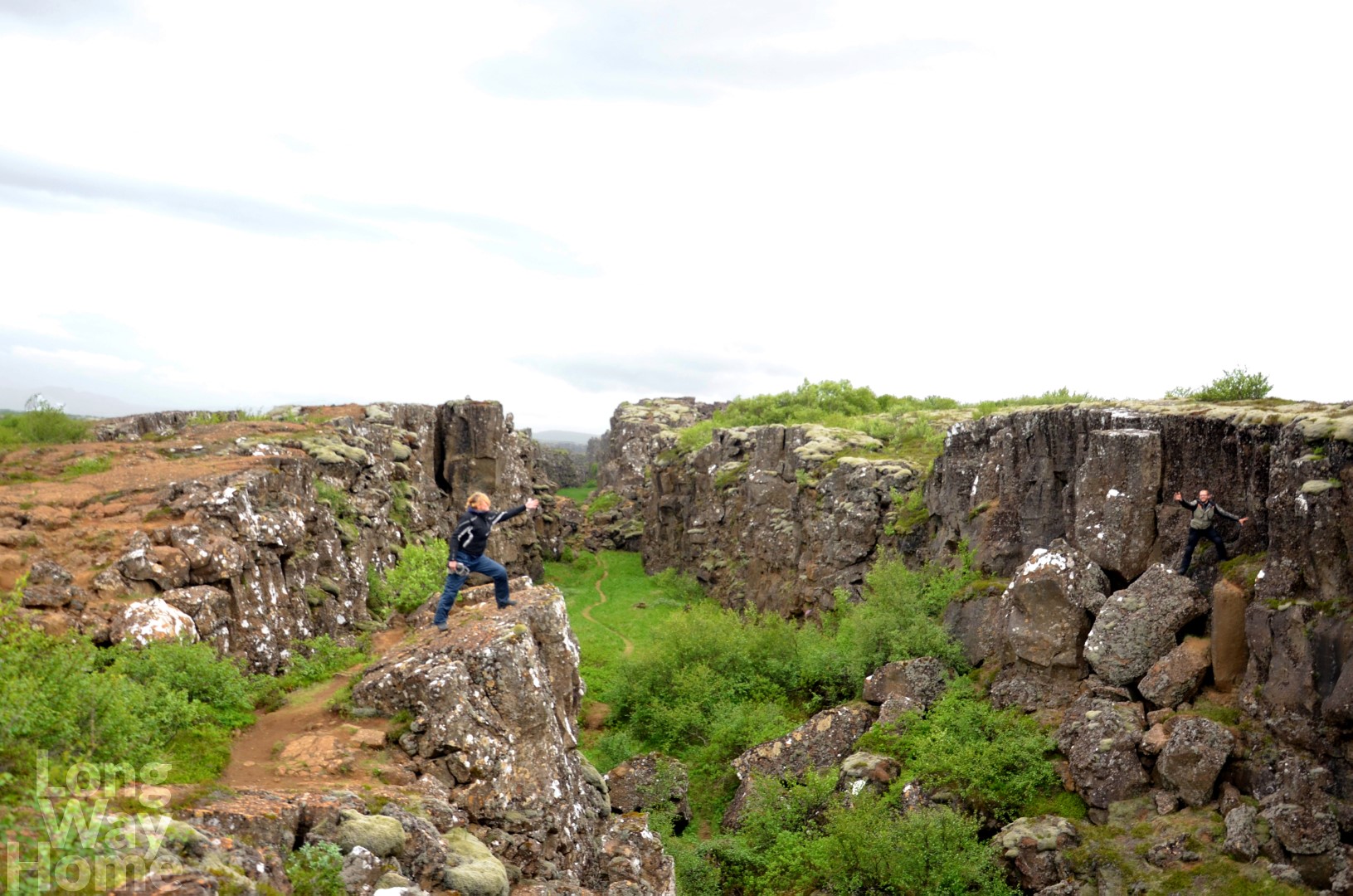
Europe – America
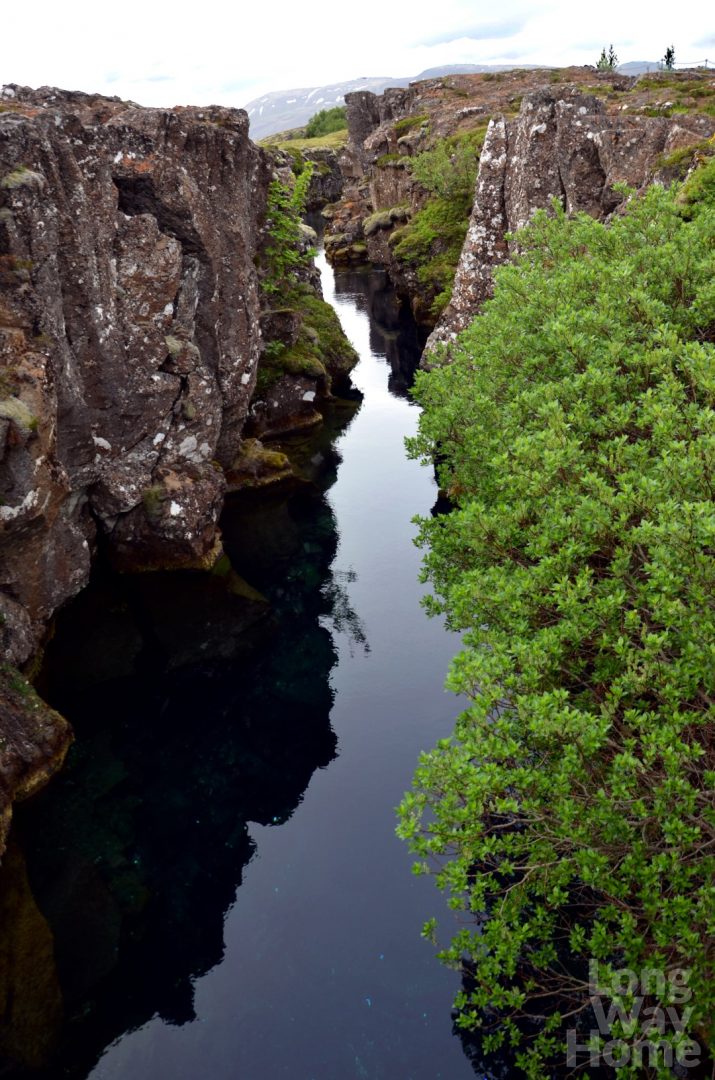
The Þingvellir lake
It starts to rain heavily again, so we quickly ride to the campsite. We get completely soaked and… we appreciate the advantages of the dryer room. 😉
Another day behind us and further impressions to remember. The only downside of today is every bit of beautiful terrain crammed by tourists. Yes, I know. We are also a part of this crowd.
Day 9. 20/06
The morning greets us quite grimly – a continuous and everlasting downpour does not calm down even for a moment since yesterday afternoon. Well, in Iceland it rains for about 290 days a year, so it has to happen someday. We find out that the sunshine surrounds the whole island… except for our place! That is why we decide to run away as quickly as we can!
Due to the late start, we cannot travel many kilometres today. We pass the famous Bláa Lónið spa (Blue Lagoon) with hot, turquoise water rich in minerals. The water is extracted from the depth of 2000 metres, then cooled down without loss of sea salt quality and sent into the Lagoon pools. Despite the world-wide reputation and fabulous pictures encouraging to use the complex, we do not decide to use it. The place is overrated for us, inadequately expensive and crowded with people. Relaxing in the water means constantly brushing against other tourists. It is not difficult to imagine what happens there in the winter when lots of Japanese arrive. Many of them believe that a child conceived during the Aurora Borealis will be a genius! We prefer a lot of natural, non-commercial and equally beautiful hot springs and pools surrounding us.
We enter the capital in the full sun, and thermometer indicates 23°C! We do not plan to spend a lot of time here, but we want to feel a bit the atmosphere of the city. Reykjavik turns out to be a little bigger than we expected. Everything we have seen so far, there were a few or a dozen houses scattered around each other and this was already called a town. Here, modern buildings randomly squeezed into free space, obscure the atmosphere of the old city. We visit the Hallgrímskirkja church, which reminds us of basalt columns at waterfalls. The architect was actually inspired by the Svartifoss waterfall. Except for the church, we look at the sculpture symbolizing the Viking boat Sólfarið (Sun Voyager). We can also see the modern Opera Harpa from this place. The building is original, all glazed and should look like honeycombs that sparkle with lights at night. It does not excite us. Should we go inside to change our mind? I move this idea away and we move on.
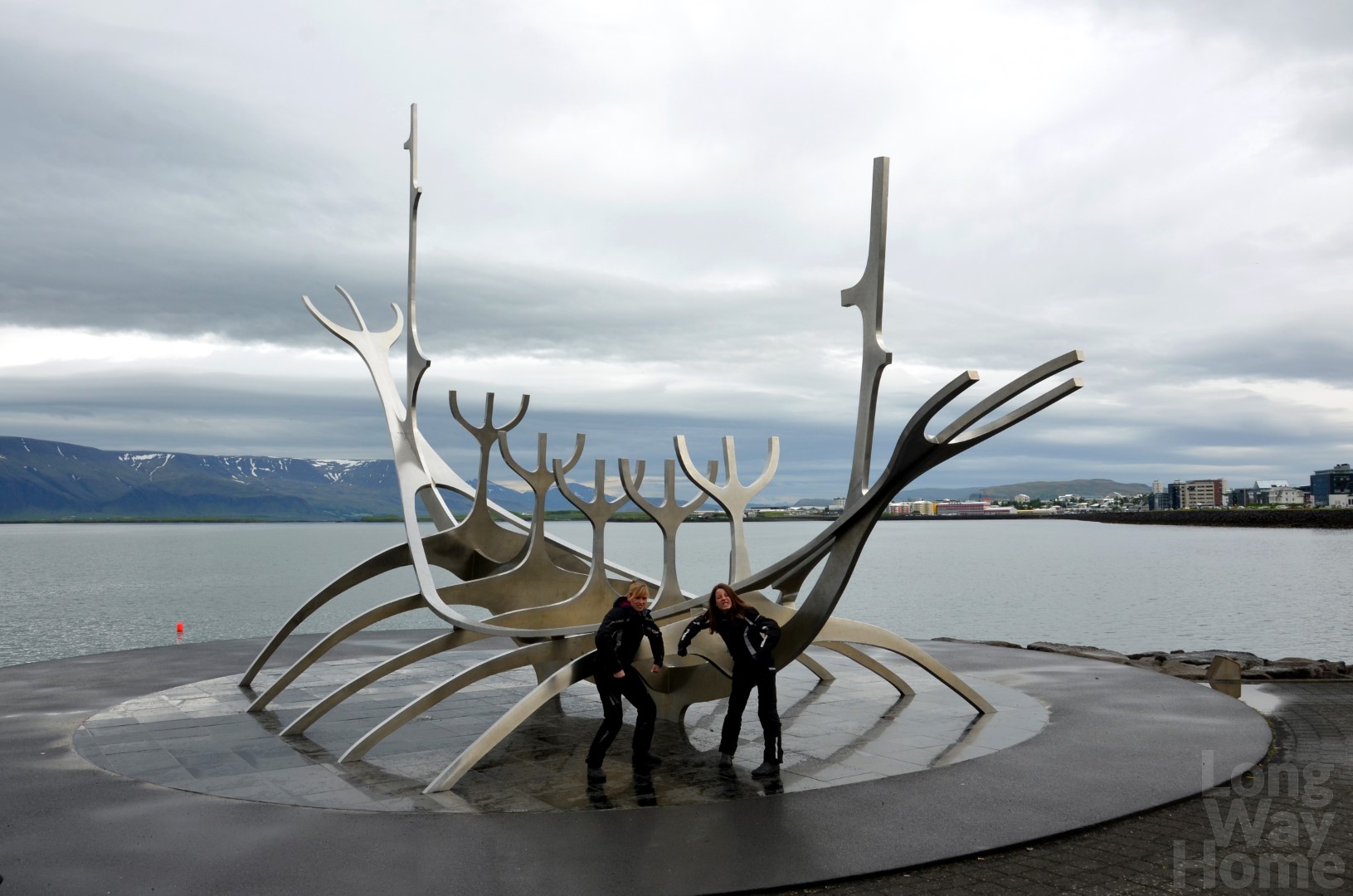
The Viking boat

The church in Reykjavik
Having left the capital, we go around the bay. We resign from paying the tunnel fee and ride extra 90 kilometres, but we absolutely do not regret it. Beautiful views from the hills, interesting and varied road turns, as well as pleasant weather, make our motorbike ride even more exciting.
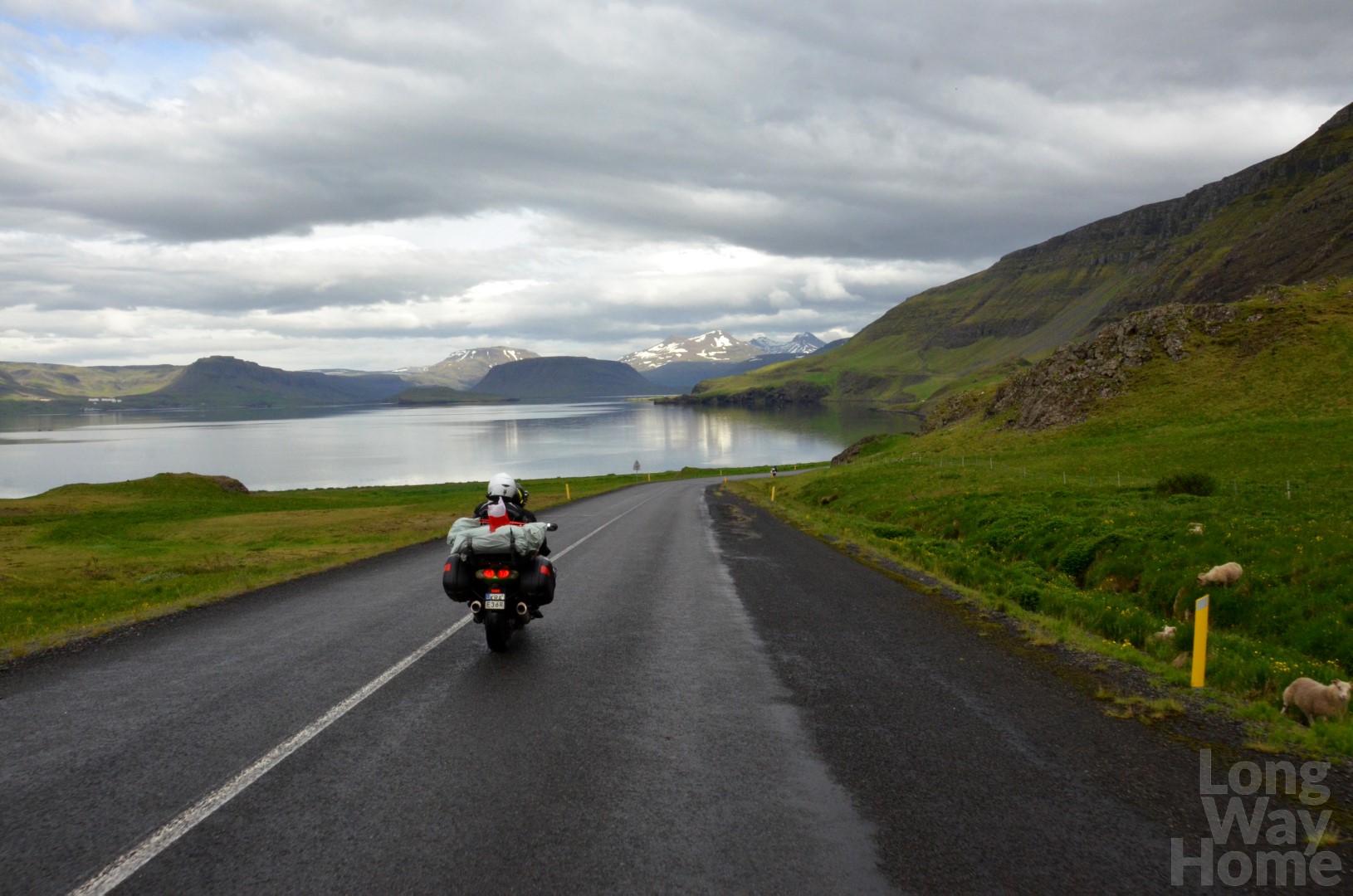
The route avoiding a tunnel between the capital and the north
We reach the beautiful, milky-turquoise Hraunfossar (Lava waterfalls) and Barnafoss (Children’s waterfall) waterfalls. The first of them is created by a series of narrow waterfalls that flow out from under the layers of solidified lava. The second waterfall is associated with a story. It has several versions, but always the story ends sadly. One of them says that two boys were left alone at home while their mum and dad went to church. They began to get bored, so they decided to catch up with their parents by a shortcut through a natural stone bridge over a Barnafoss. When they walked over a waterfall, they got dizzy, fell into the water and drowned. After hearing about it, the mother put a curse on the bridge saying that whoever wants to pass this way, will drown. Soon after, before anyone tried to cross it, the bridge was destroyed by an earthquake. Another story says that mother destroyed the arch to ensure no one else faces a similar fate to her children.
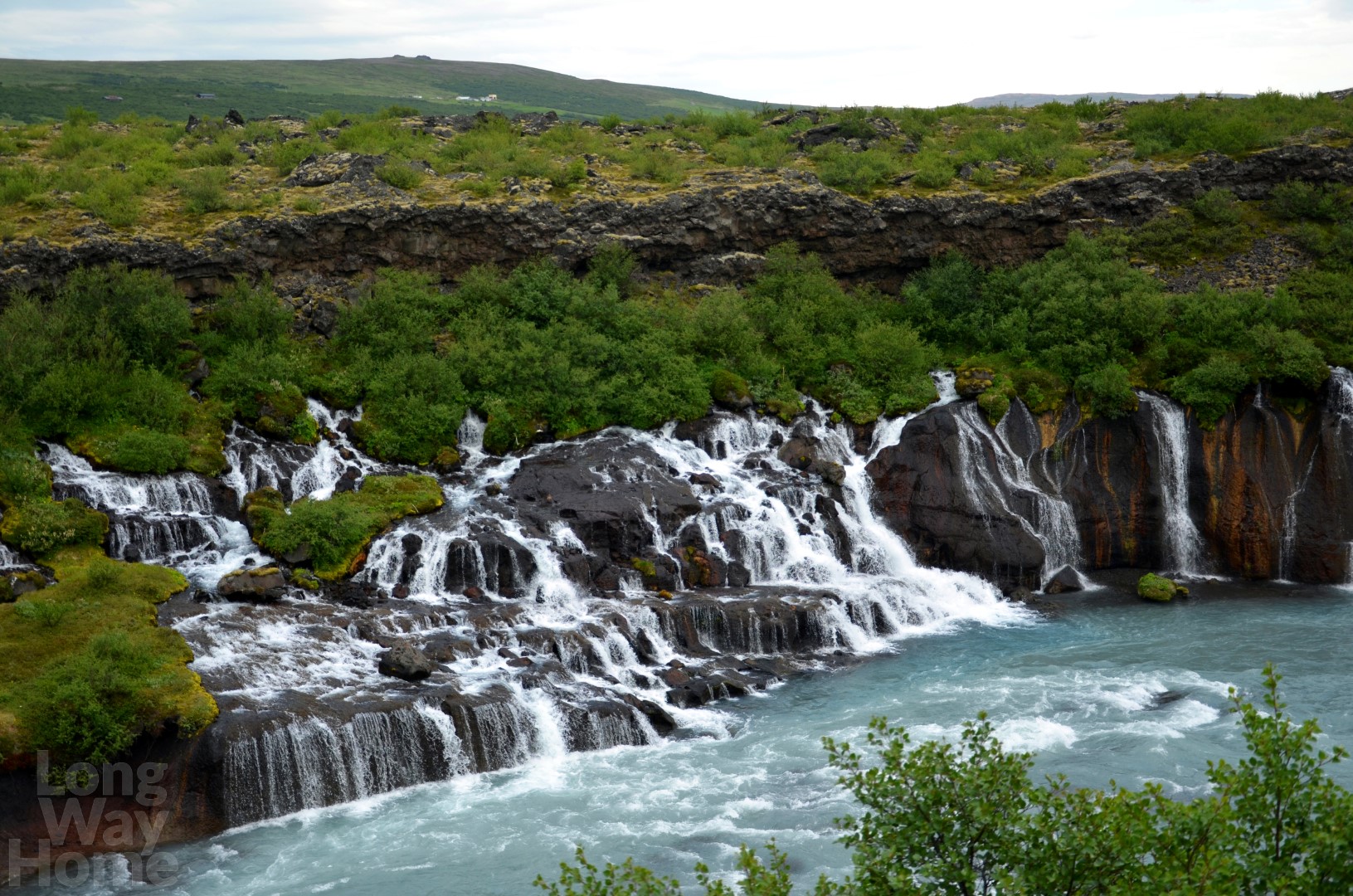
The Lava waterfalls
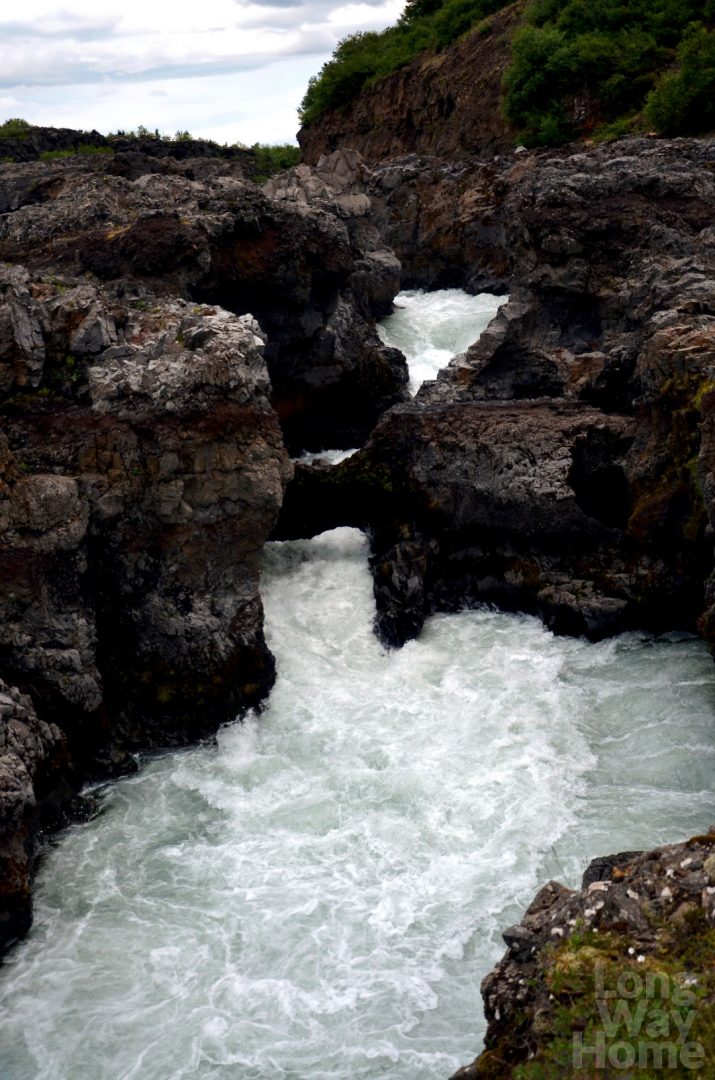
The Barnafoss waterfall
We meet three bikers on the BMWs GS1200. Two of them won a three-week motorcycle trip in Iceland for the best picture of motorcycle equipment. The third man rides with them and works to create a photo-story for the magazine that sponsors this trip. This is an interesting job! After a moment of chat and exchange of experiences, trying to hide from a countless number of flies that surrounds us, we find a place for wild camping near the river flowing from the waterfalls. This time, we remember that we cannot count on the twilight indicating time to get some rest and we go to sleep at a decent time.
Day 10. 21/06
It is about time to explore the north. Unfortunately, we have to skip the western fjords (we leave it for the next time), because we only have two days to sail back.
In order not to return to the main road along the same route, we choose a different, smaller, gravel and more interesting one. But when the next parts of the road get covered with tarmac, the ride begins to get boring, although the views are still unusual and phenomenal.
Every now and then we enter a cloud of stormy sand carried by the wind. And this strongly circulating wind makes mini tornadoes and sandstorms. Otherwise, the road is straight and dull. To fight sleepiness while on a road, we create various layouts, configurations and record videos that make our trip more interesting.
Suddenly, a person standing in the middle of the road stops us. This is a local farmer letting his horses cross the street to the farm. We wait patiently until all the animals pass and then we move on. Several dozen horses gallop along the road, the rush winnows their thick manes, the dust rises from under the hooves, and we pass them rushing on our mechanical steeds overawed by this beautiful view.
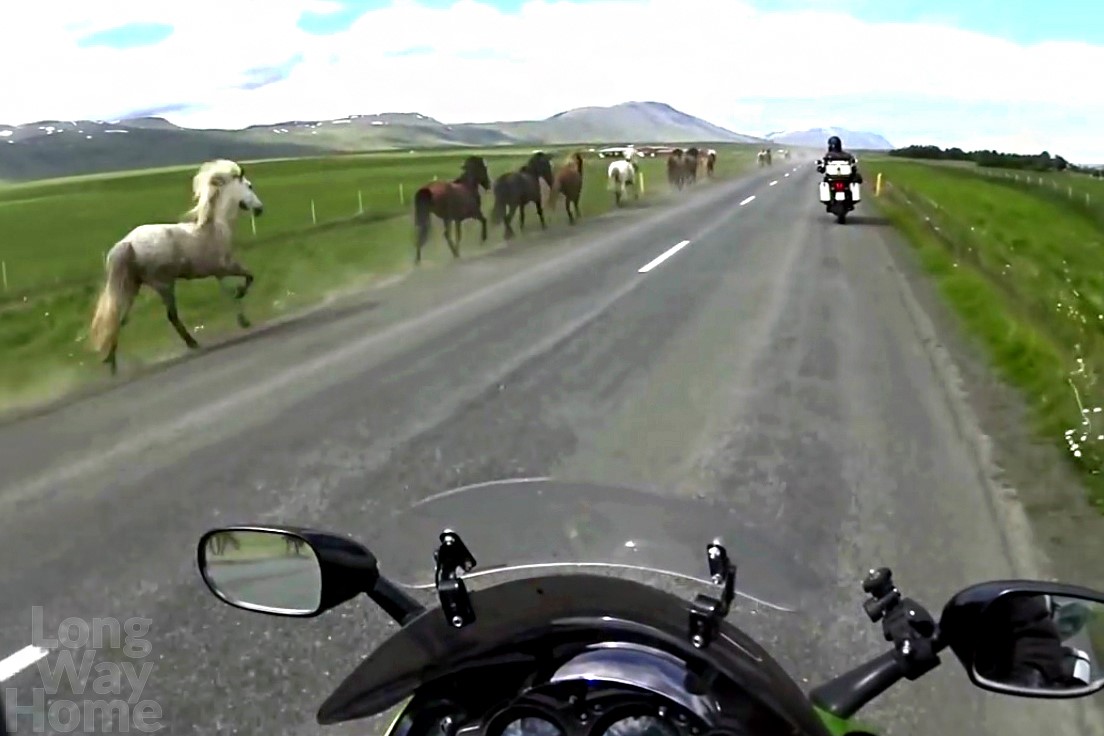
The herd of horses overtaken by us
We organise a lunch break in Varmahlíð, where the charming houses are made of peat, and the roofs are covered with grass. You can walk between them or look inside to go back in time and see what tools were used in the past. We relax, we catch the sun, we warm up. It is probably the first such stop, where we have some time for ourselves and no longer have to hurry.
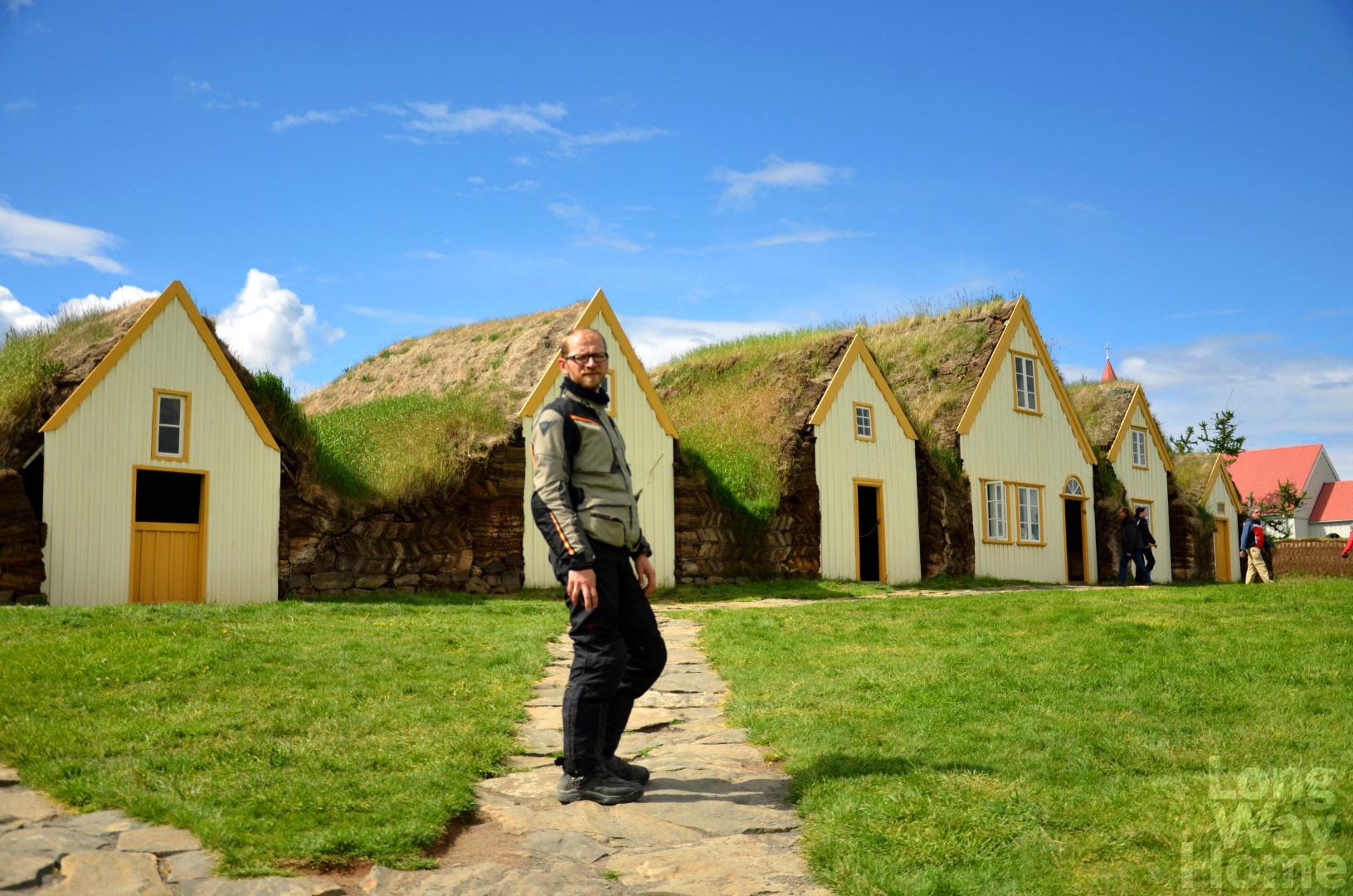
Varmahlíð
In Akureyri, the “second capital” of Iceland, we replenish food and fuel supplies. We meet a Polish woman who studies here as part of the Erasmus program. Together with her boyfriend, they want to ride the island by motorbikes. We share our experience, exchange a few sentences and… we leave the city not visiting it.
In the evening we reach Húsavík, where we intend to swim in a hot lake. This “heat” is relative because the water turns out to be only lukewarm, but we still take a bath in the wonderful scenery. Surrounded by fields of blooming lupines and snow-capped mountains in the background, the lake glistens in the sun. Despite 9 PM, the sun shines brightly above our heads. At around 1 AM it will approach the horizon, bounce off an invisible line over the ocean and start to rise again. Incredible! Before this time comes, we pitch tents near the lake, still having the same beautiful view. We wait for the “midnight sun”, capture it in a few pictures and go to sleep, although we do not feel like it at all.
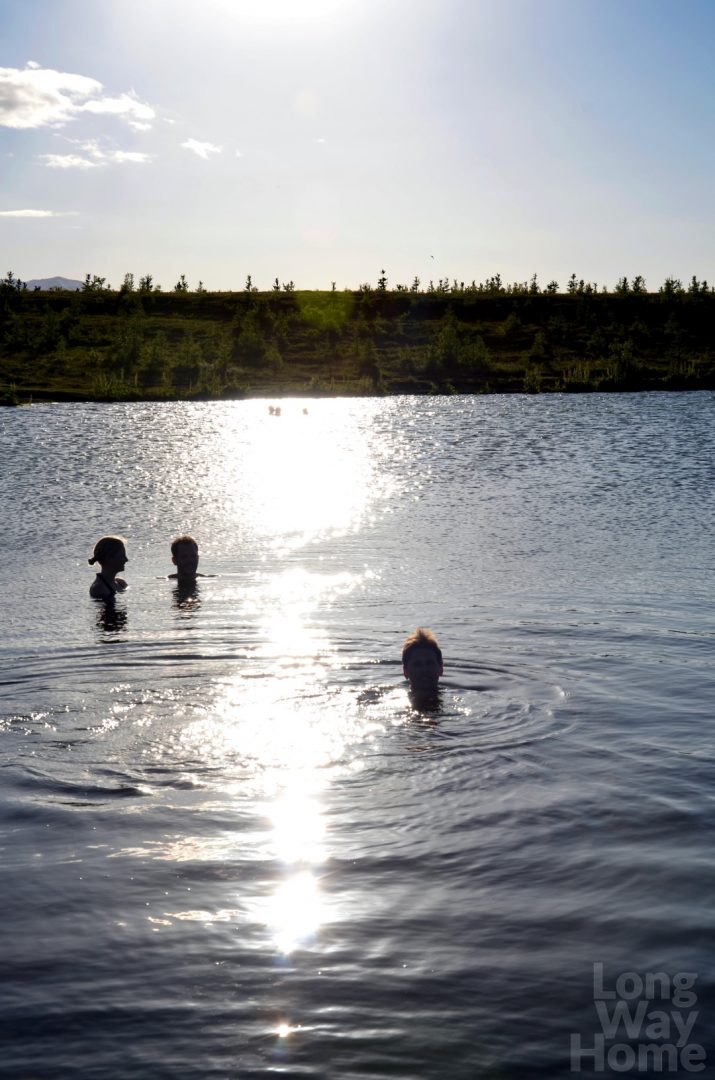
The warm lake close to Húsavík
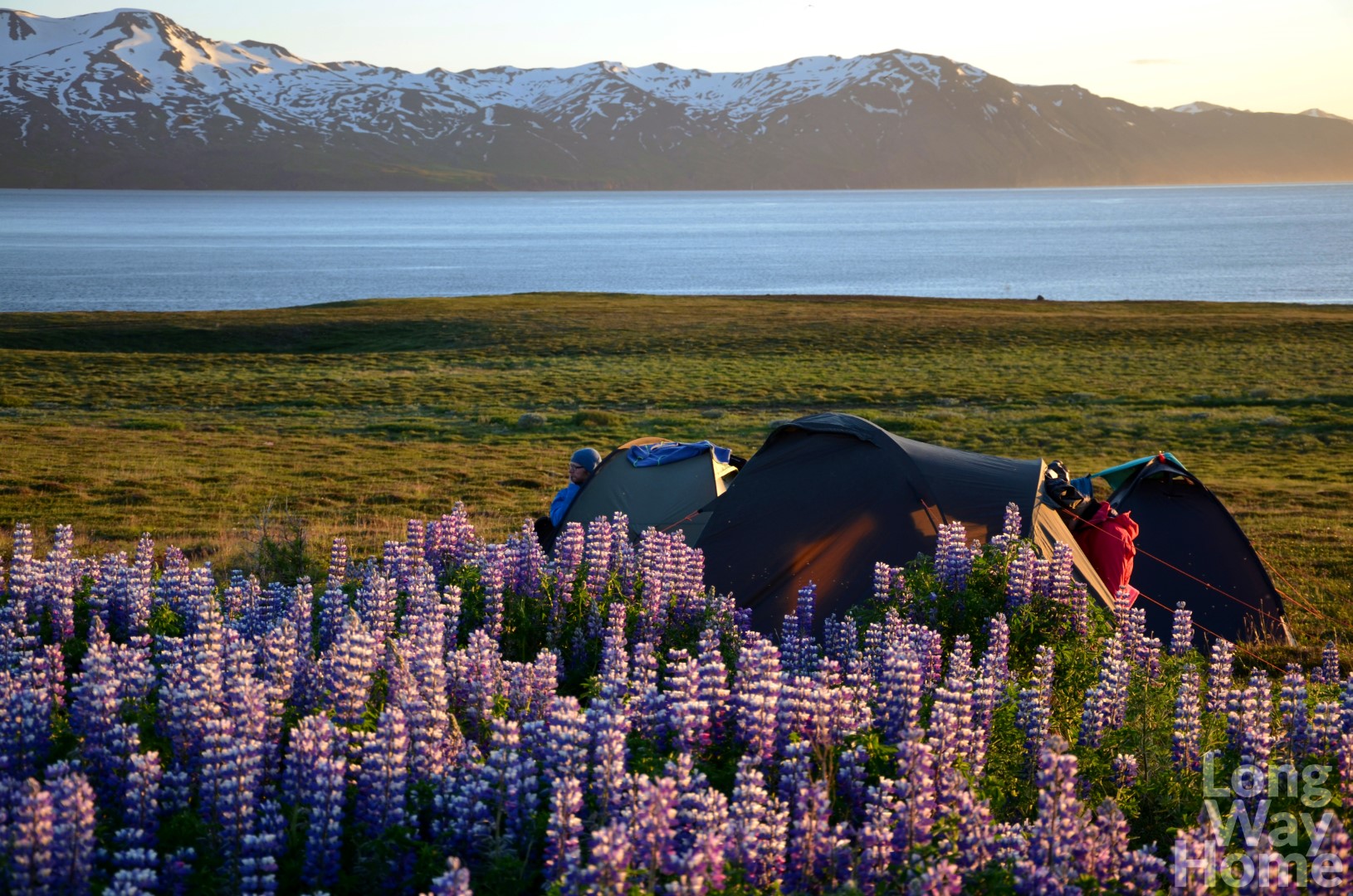
The most beautiful wild campsite
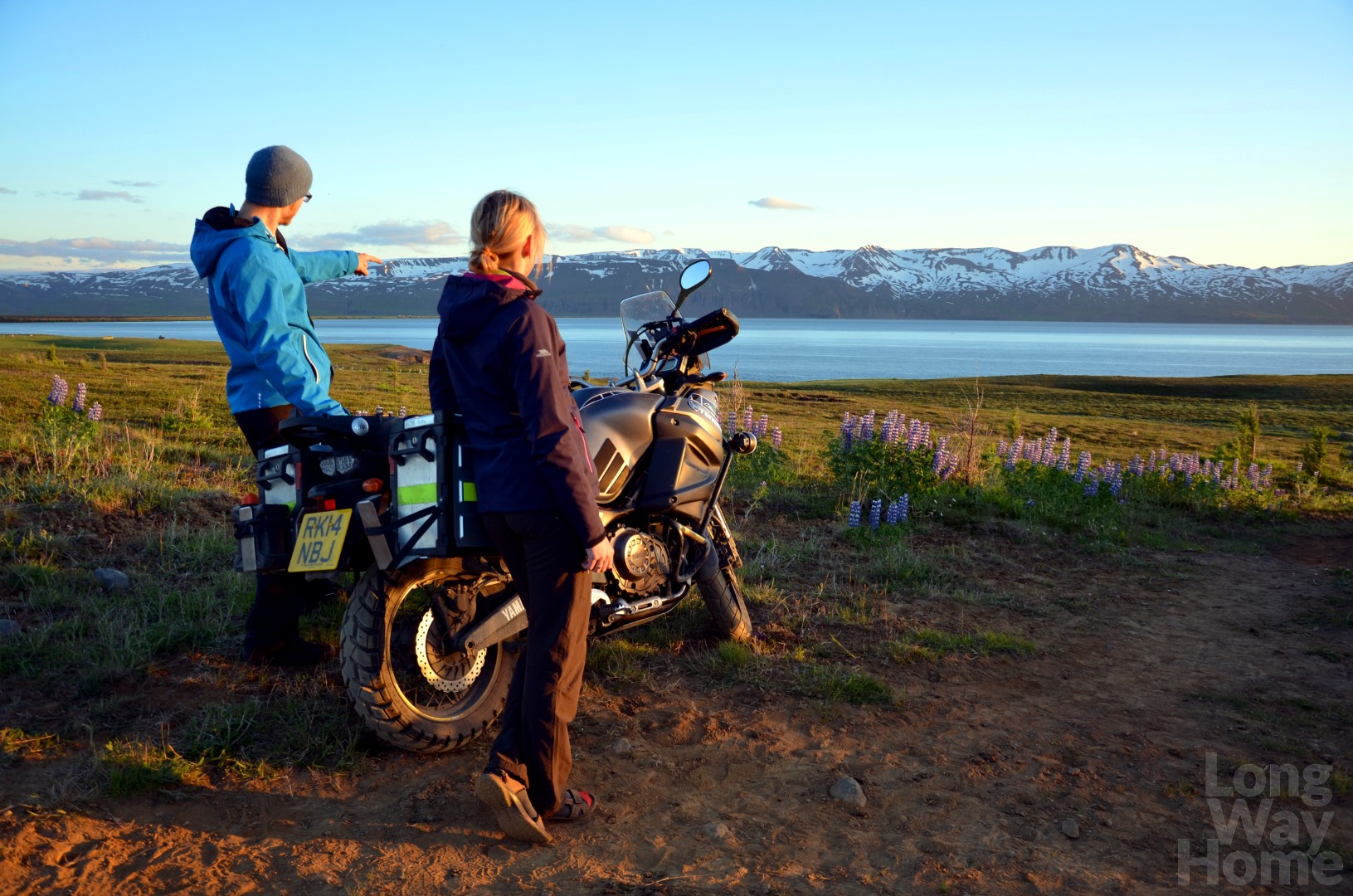
Húsavík area

“The midnight sun”
Day 11. 22/06
Last day on the island. We wake up in one of the most beautiful places we have ever stayed in.
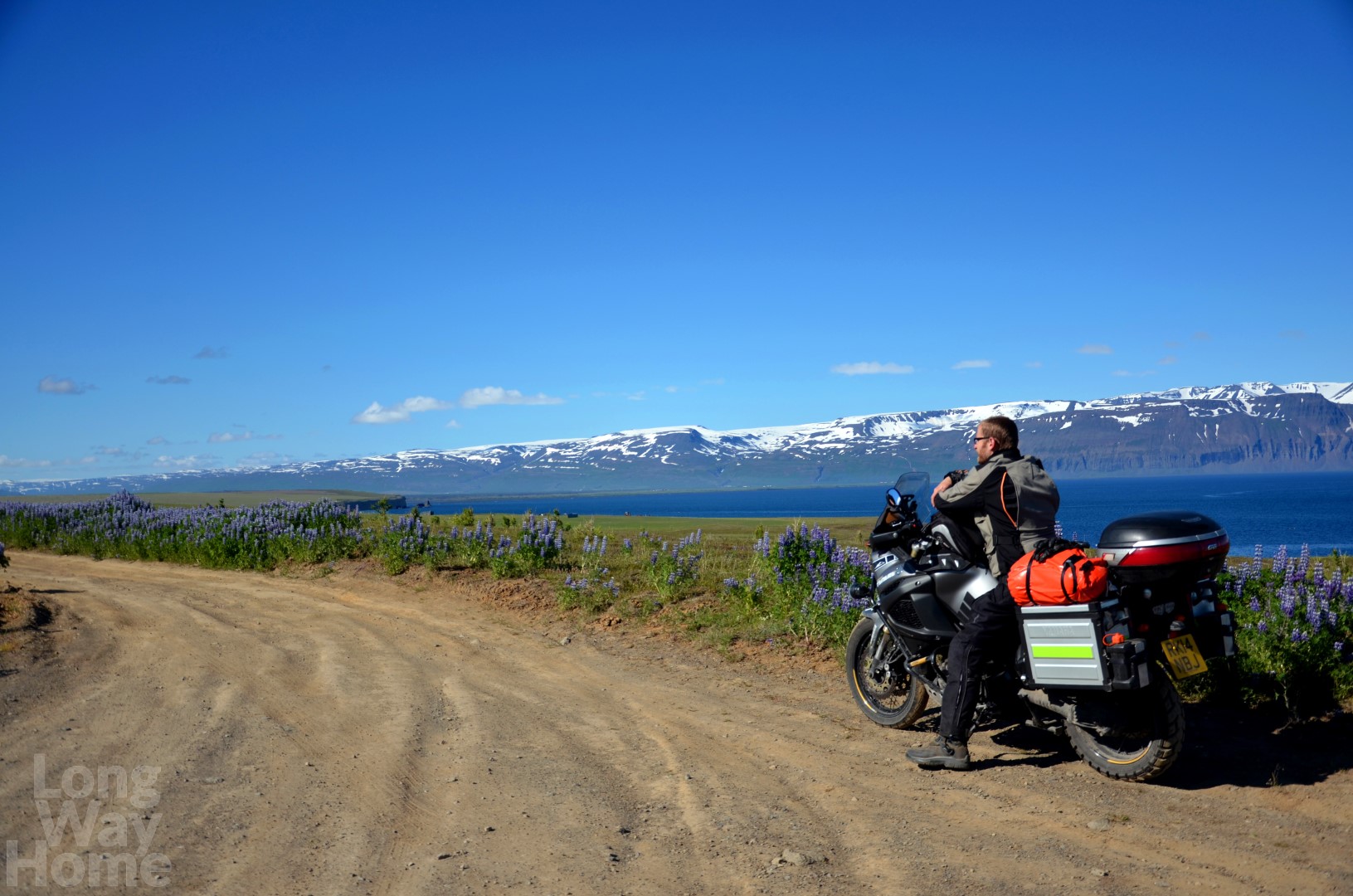
We start riding on the gravel roads, which means 43 kilometres of larger and looser stones. It is interesting and Łukasz has a lot of fun with traction control switched off. Black colour assumes a new meaning because our clothes absorb all the dust off the road and become brown-grey.
We stop by the huge Dettifoss waterfall. The amount of water flowing through it (193 m3/sec) is the largest amount of all European waterfalls and could energise entire Iceland with its power. And here the scene for the film “Prometheus” was shot. The sun tries to bake us, but it does not last long. By the end of the day, it will rain and the temperature will drop dramatically.
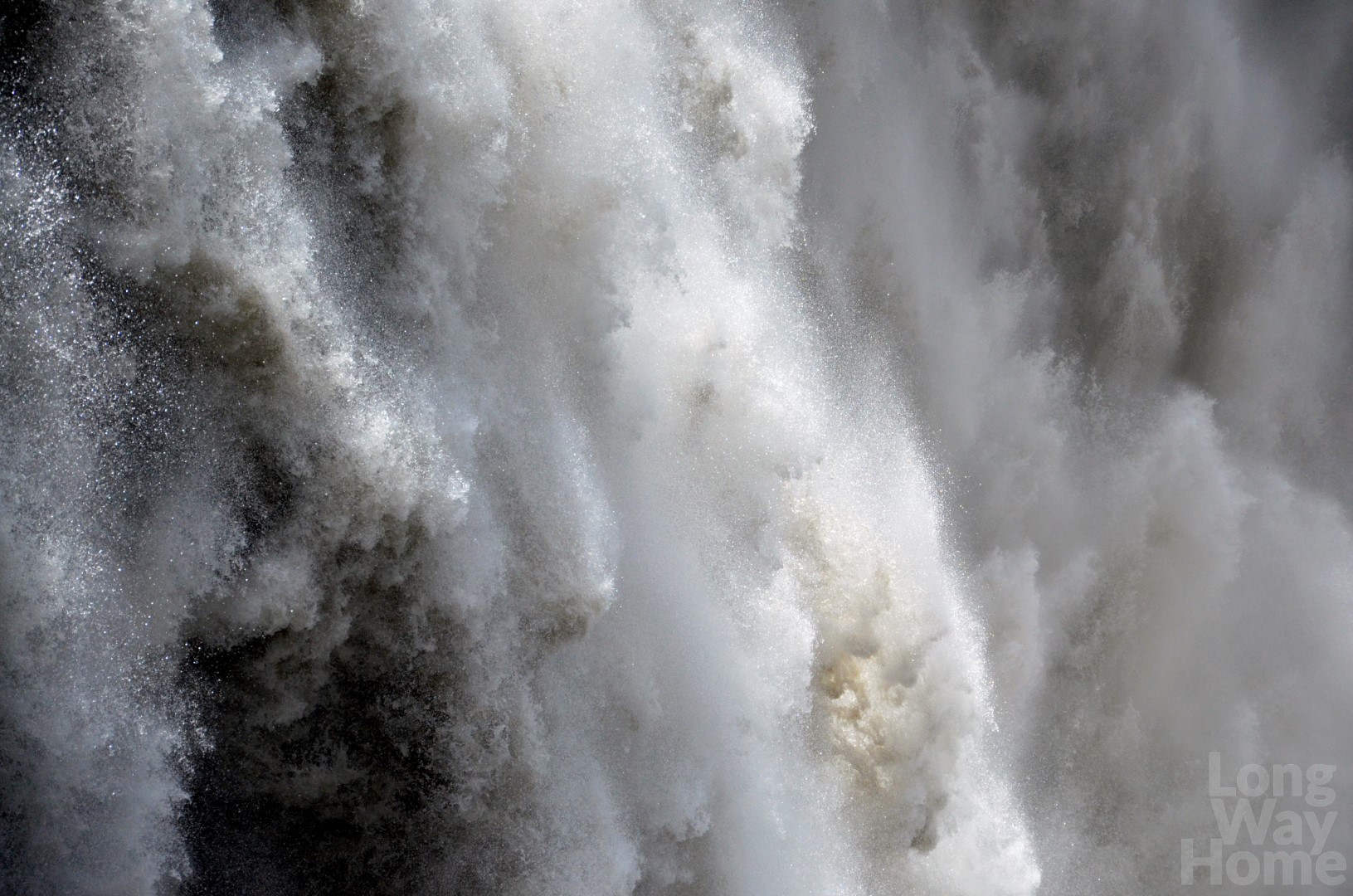
The great power and rush of water from Dettifoss
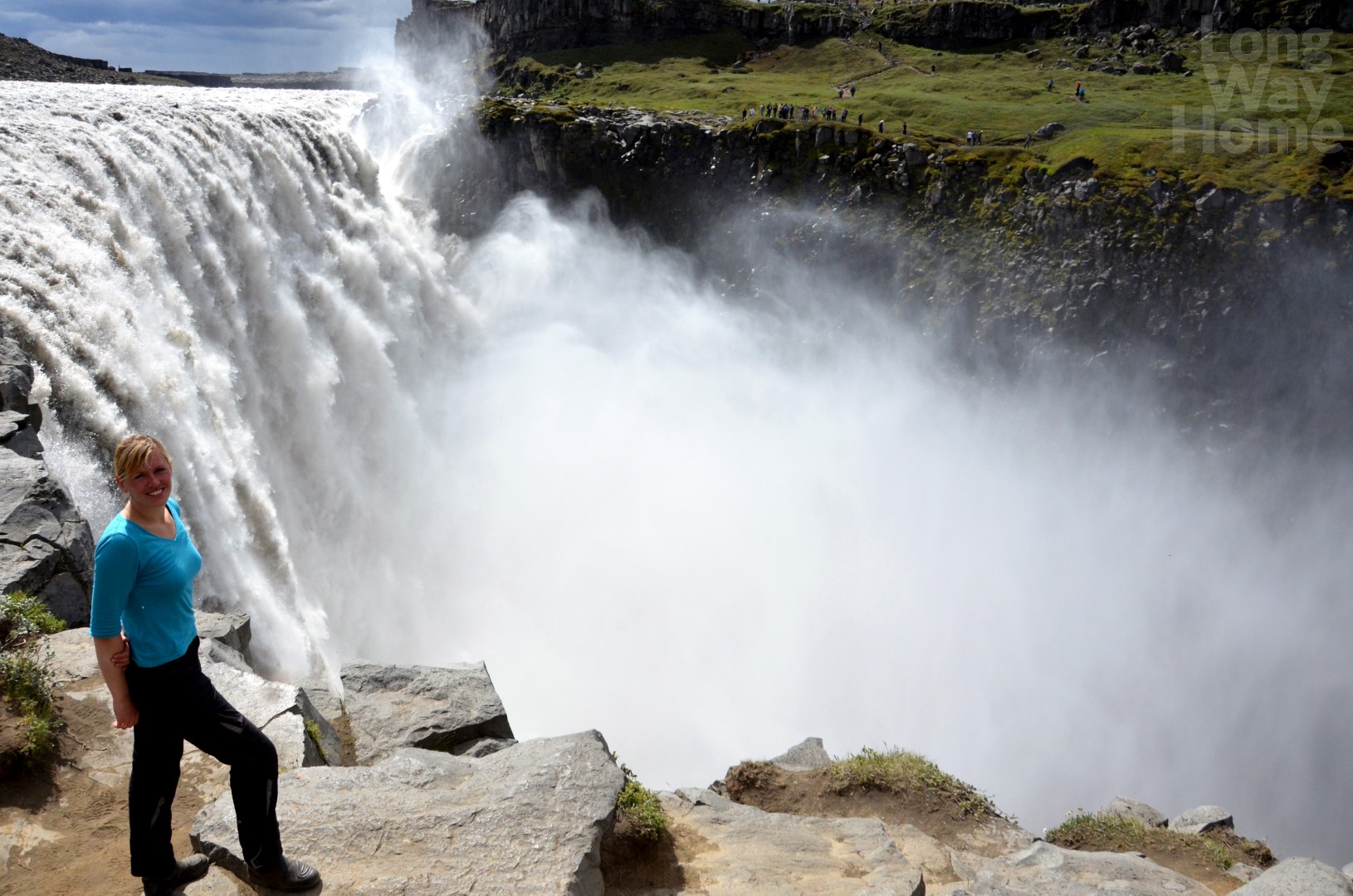
The Dettifoss waterfall
We speed to Hverarönd – a geothermal field full of mud ponds, hot springs, smoking chimneys and fumaroles. We walk between them admiring the lunar landscape. I am delighted with a mixture of colours. Dark grey bubbling mud pours on the cracked honey-brown ground. We also stop at an intense light-turquoise lake and enter the Grjótagjá cave. It was created as a result of the eruption of the volcano and the flowing lava that way. The very clear water used to have a temperature of 60°C, which has now dropped to 43°C. Unfortunately, bathing is forbidden.
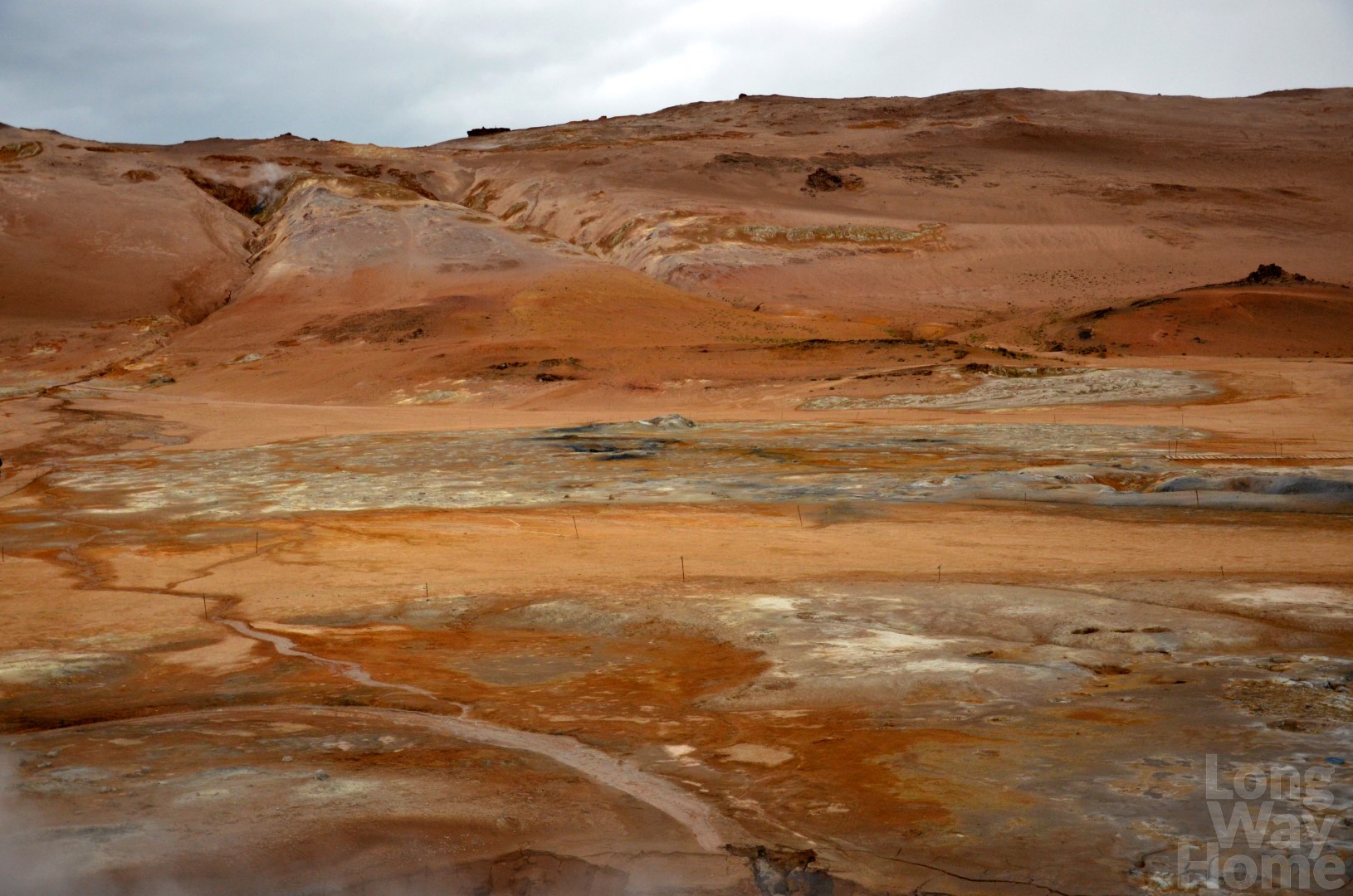
The geothermal field Hverarönd

The geothermal field with hot springs
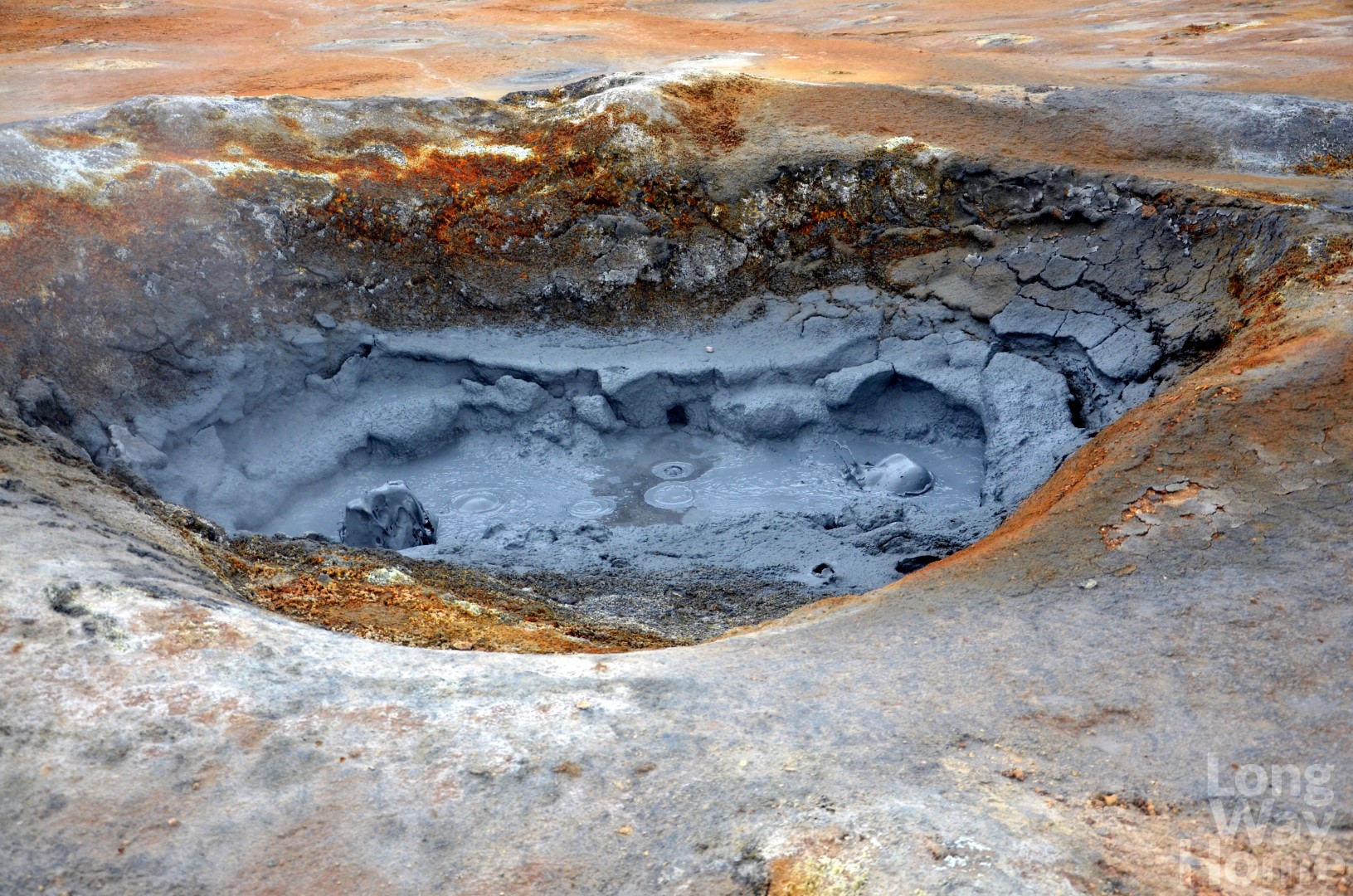
The bubbling mud
Going farther, we turn in the side lane which narrows to the point that it turns out to be a private path. Instead of the host, Ewa opens the gate and releases us on the main road.
The road is long and mainly winds in valleys surrounded by gentle mountain and hill slopes. We are accompanied by cascading waterfalls flowing down from them. The last 20 kilometres runs up through steep switchbacks, where we suddenly enter a completely different world. The “world” in this altitude consists of snow, heavy clouds, fog as thick as spilt milk and peaks of mountains emerging from it. The temperature immediately drops to 6°C. In this conditions, we reach the place, where our Icelandic adventure started. Seyðisfjörður is a town to which Walter Mitty got in on a skateboard (we recommend this movie!). Here, as most of the travellers, we pitch up tents to be able to get up early in the morning and line up for the ferry…
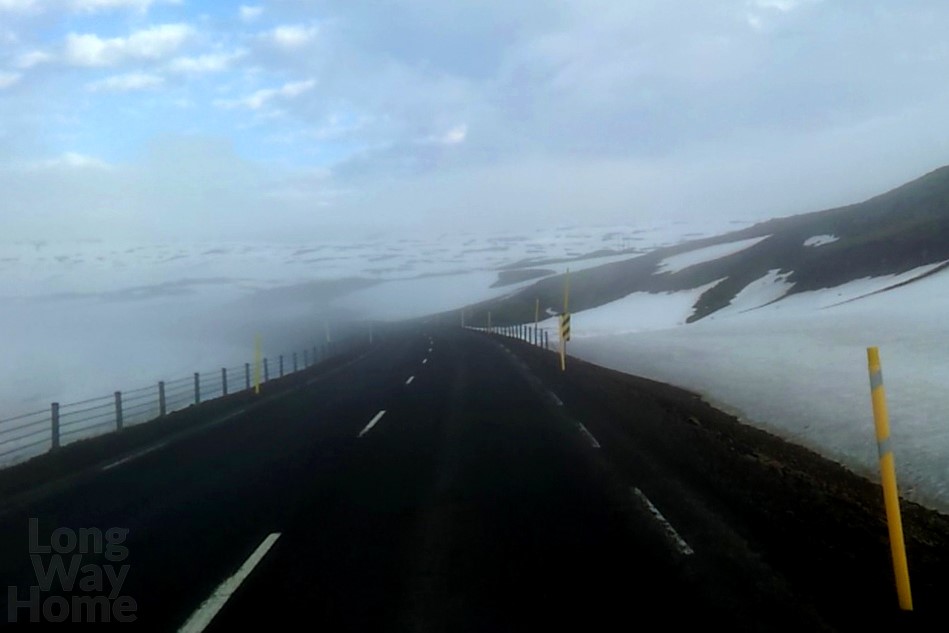
The switchbacks leading to the harbour through mountains
Day 12. 23/06
Check-in for the ferry is required up to 3 hours before departure and so we get there quite early. It turns out that the ferry is late, so we spend the whole morning in the harbour. The fog descends showing the clear blue sky, so waiting time we spend on relaxing. We talk to other travellers who, like us, have been touring the island, exchange impressions and experiences.
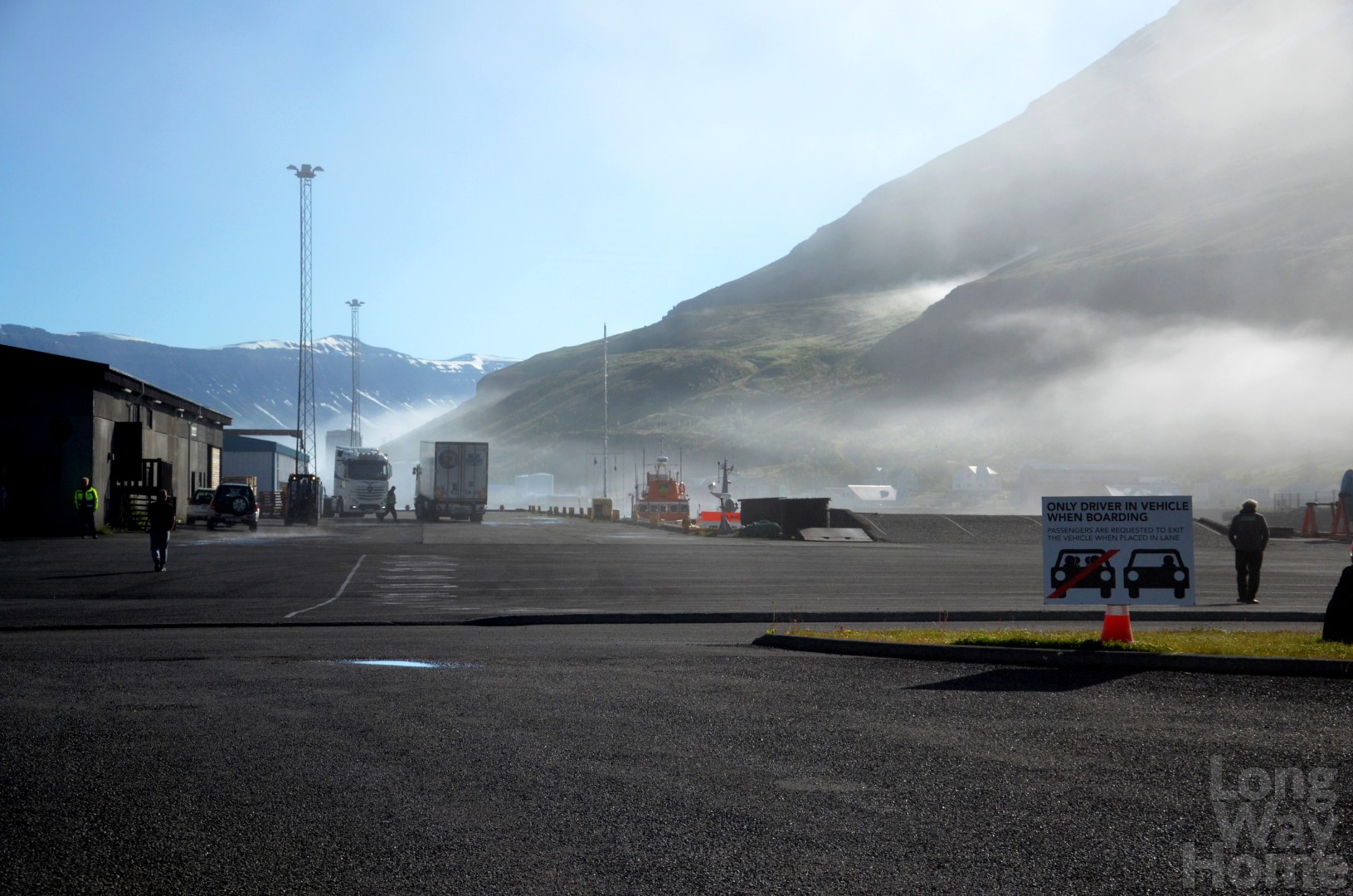
The hazy morning at the harbour in Iceland
Finally, 6 hours later we are located in our cabin (of course under the car deck). Most went to bed right after lunch and sleep until the next morning. Łukasz and I go to the terrace and sit comfortably on the deckchairs. While sipping a beer, accompanied by wind and music coming from the bar, we sum up Iceland itself:
– weather taking into account the location and wildness of the island – sensational!
– roads, except for the island ring road number 1 which sometimes made us bored – great!
– sleeping in the wild – wonderful!
– we feel a bit unsatisfied with Iceland unknown to tourists exploration and thus the interior. We have a plan to return here on two light off-road motorcycles and go deeper into the island.
– Iceland is much more beautiful away from tourists and tarmac roads, however the most beautiful is the most popular. Fortunately, there are also beautiful places inaccessible to “ordinary” car drivers, where you cannot meet anyone throughout the day.
The time for relaxation on the ferry benefits us before we explore the Faroe Islands. Because this is not the end of this adventure…
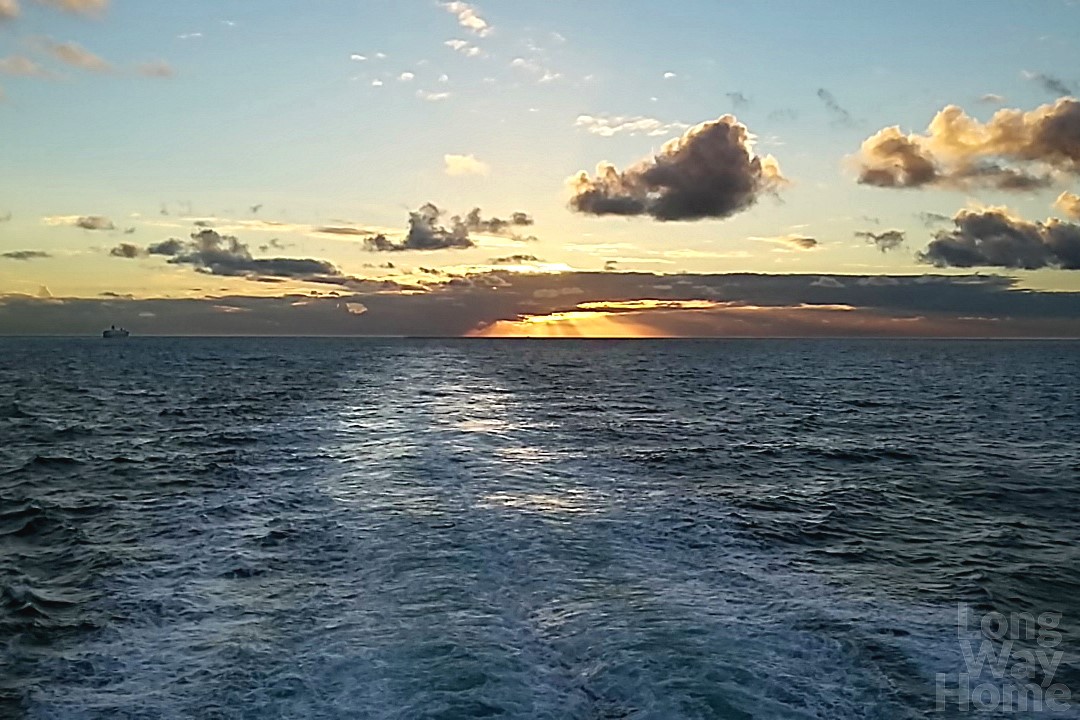
On the ferry towards the Faroe Islands
Continuation of our journey at the Faroe Islands.